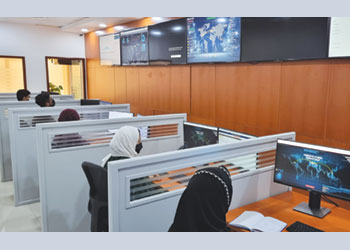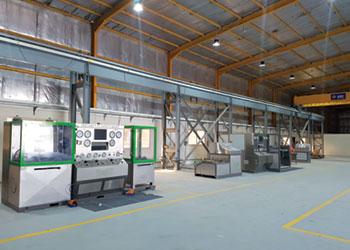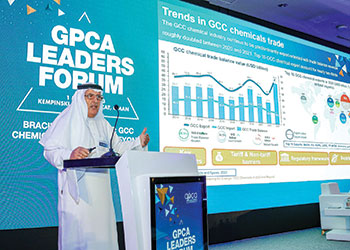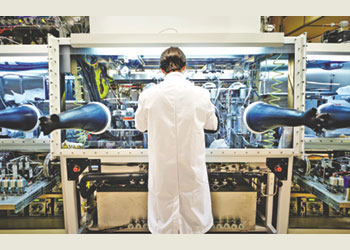
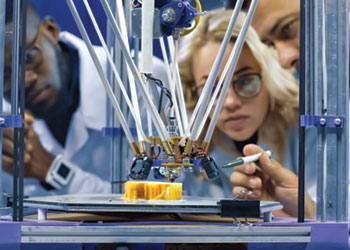 New products will drive growth of the materials industry
New products will drive growth of the materials industry
The creation of new materials is driven by innovation and increasingly sophisticated end uses, and this offers Europe's chemical industry to compete on innovation, rather than just costs, write Dr Bernd Elser, Dr Paul Bohm and Sean Keenan*
The materials industry is on the verge of a new era, with the creation of a range of new materials in a revolution driven by technology-enabled innovation. These materials include self-healing materials that can recover from scratches and cracks, metal foams that are lighter than traditional metals while providing the same strength, and willow glass that is strong, lightweight and conformable.
This growing range of new products is likely to drive the next wave of growth for the materials industry, and European chemical companies in particular will need to adopt new business models and compete more effectively in global markets.
To succeed, they will need to rethink their value chains, expand manufacturing capabilities and capacity in the region, and take advantage of digitally powered approaches to faster, more focused innovation.
Ultimately, the revolution in materials has the potential to transform the industry and empower it to help address some of the world's most fundamental issues, from providing affordable green energy to the elimination of hunger and making clean water available to all.
New materials coming to market will create new possibilities for companies across sectors and reshape many end markets. For example, stronger and self-healing coatings on vehicles will have a significant impact on local auto repair markets, while carbon-fiber enforced concrete is bringing more flexibility to the design of building projects.
New advanced materials, such as metal-organic frameworks, graphite-oxide sieves, nanosilver paper, and nanocarbon springs, are opening up new sources of growth for chemicals and other materials manufacturers. Growth rates are expected to be higher than those of traditional materials in the coming years, creating an estimated $150 billion growth opportunity by 2025.
This growth is driven by fundamental trends such as the increasing focus on affordable and clean energy, good health and well-being, and other United Nations Sustainable Development Goals (SDGs). The innovative advanced materials now in place or being developed support and directly contribute to meeting many of the SDGs, such as clean water and sanitation.
New opportunities and growth are also linked to fundamental changes in the materials markets across three key dimensions: convergence of material classes, convergence of material and digital properties, and a shift to smarter, more sustainable materials.
CONVERGENCE OF MATERIAL CLASSES
Accenture analysis of patent filings over the last four decades shows that innovation in materials has involved the increased convergence of material classes.
In 1980, 70 per cent of materials patents cited just one material, and by 2020, just 46 per cent cited one material and 24 per cent cited three or more.
Multi-material patents citing enhanced sustainability properties have risen from 2.4 per cent to 8.7 per cent during this same period, indicating the growing connection between sustainability and innovative materials.
CONVERGENCE OF MATERIAL & DIGITAL PROPERTIES
Accenture's patent analysis shows an increase in patents for materials that have digital and smart properties.
In 2020, 24 per cent of patents refer to the digital and smart characteristics of a material, compared to 4 per cent in 1980.
This increasing convergence means that chemical and other materials companies need to build new capabilities to handle, deploy and use digital and smart materials.
Some of these capabilities can be built in-house, while others will require partnerships and new ways of going to market.
SHIFT TO SMARTER, MORE SUSTAINABLE MATERIALS
Innovative materials offer a range of new properties, with a focus on smarter and more sustainable qualities.
Smart materials include shape-memory polymers that can be deformed and returned to their original shape, vanadium oxide that remembers its exposure to stimuli, and flexible solar panels and perovskite solar cells that are twice as efficient as traditional solar cells.
Wooden mass timber skyscrapers are based on green building materials, providing structural stability and reducing buildings' need for cement. These buildings could also create opportunities for the chemical industry to provide new protective coatings and wood-bonding solutions.
NEW BUSINESS MODELS
The effective creation, production and delivery of new materials will require change, not only in the materials sector, but across industries.
Development and marketing will need to move closer to end customers to drive innovation, reshaping and disrupting existing value chains.
Circularity will create opportunities for companies to adopt new business models that use new materials to enable more reuse, mechanical and chemical recycling, and energy recovery and carbon utilisation. This will provide another avenue for competition and growth.
HOW CHANGE WILL HAPPEN
The materials revolution offers a bright future. However, innovation is often based on additional developments of existing materials, which means it relies largely on existing production capabilities—and for European chemical and other materials companies, that presents a challenge.
Europe's share of global markets has declined significantly over the last two decades, with much of this being lost to China.
In many materials categories, reductions in market share have outpaced the loss of gross domestic product (GDP) share, leaving Europe with less manufacturing capacity to take advantage of innovative materials.
For example, the European share of steel and cement has declined 70 per cent and 67 per cent, respectively, compared to a 26 per cent drop of GDP share. This indicates that Europe could find itself with relatively less manufacturing capacity to draw on in the race to take advantage of innovative materials.
However, the new materials landscape is still in flux, with startups playing a significant role in its development.
Europe has a sizable base of startups, which have brought investments in fields such as composites, bio-based materials and sensors.
Companies and governments should work to foster startups in order to strengthen the region's new materials business, and European companies can draw on today's increasingly powerful science technology to improve innovation efforts.
Science tech combines cloud, data, analytics, artificial intelligence and automation to allow virtual rather than physical experimentation with new materials, bringing greater speed and better targeting to innovation.
Accenture’s analysis of priority patents shows that filings based on traditional approaches declined or grew only slightly in the past few years, while those involving disruptive innovations derived through computational chemistry had a notable increase.
TAKING THE NEXT STEPS
The industry, companies and governments need to make innovation in materials a priority and pursue several key actions such as expand funding for corporate innovation and startups while also provide funds for the transformation of industrial assets and plants.
In addition, setup frameworks, structures and ecosystems to support collaboration and capabilities and also invest in building new skills, talent, innovators and entrepreneurs with a focus on new materials.
This revolution will not only provide new products to bring to market, but also change the competitive landscape by allowing European chemical and other materials companies to compete on innovation, rather than costs. It will enable the sector to play a vital role in increasing sustainability and building the circular economy, and it will allow companies in Europe to keep uncovering new ways to win in global markets.
* Bernd Elser is a Senior Managing Director of Global Chemicals Lead and Global Natural Resources Lead at Accenture, Dr Paul Bohm is a Strategy Senior Manager of Chemicals and Natural Resources at Accenture, and Sean Keenan a Senior Principal of Natural Resources Research Lead at Accenture.
By Zainab Al Taitoon



















































































